Non-Linear Qualitative Dynamic Analysis of Supercritical Water-Heated Channels under External Vertical Accelerations
Abstract
Featured Application
Abstract
1. Introduction
2. The Model and Solution Method
- The whole system is assumed as a rigid body;
- The system is retained at a supercritical pressure of 25 MPa under both static and external vibration conditions, while the pressure drop through each channel is usually far less than the system pressure;
- Each channel is supposed to have a uniform heat flux distribution along the axial direction;
- The same constant inlet enthalpy is distributed over all channels under both static and external vibration conditions;
- The parallel channels possess the same pressure drop under both static and external vibration conditions, as they are connected by the common upper plenum and lower plenum.
3. Validation of the Model
4. Results and Discussion
4.1. Stability Map of the Static System
4.2. Non-Linear Seismic-Induced Oscillations
4.2.1. Seismic-Induced Oscillation of Single Channel System
4.2.2. Seismic-Induced Oscillation of Parallel Three Channel System
5. Conclusions
- The strength of seismic-induced oscillation is relevant to the inherent stability natures of the initial state.
- The effects of parameters on the seismic-induced oscillation conducted in single heated channel indicate that unstable influences could be caused by a longer heated length, uprating operation power and the increase of outlet loss coefficient, while stable effects could be illustrated by the increase of inlet loss coefficient, a larger channel diameter and a lower inlet fluid temperature.
- For a three supercritical heated channel system with a heat flux ratio of 1.2:1.0:0.8, in the region with NP-SUB greater than 1.67, the dimensionless natural frequency on the stability boundary is mildly increased as NP-SUB is decreased, where the heavy fluid region contributes a substantial role in the channels. However, in the area with NP-SUB less than 1.67, it would significantly increase as NP-SUB is further decreased, which is due to the effect of light fluid region dominating over the channels.
- The seismic-induced effects on parallel heated channels are related to the inherent stability characteristics of initial state and the interactions among channels. The effects of inlet loss coefficient and outlet loss coefficient on the vibration-induced oscillations among channels may depend on the operating conditions, which are affected by the power-to-flow difference among channels and stability nature of the system. The more uneven heat flux distribution among channels would cause a larger vibration-induced oscillation.
- The strength of vibration-induced resonance oscillation among parallel channels is closely related to the inherent stability characteristics of initial state. It may trigger much larger resonance oscillations than in the case of non-resonance.
Author Contributions
Funding
Informed Consent Statement
Data Availability Statement
Conflicts of Interest
Nomenclature
| a | acceleration (ms−2) | NP-PCH,j | pseudo-phase change number for j-th channel, |
| apeak | peak acceleration (ms−2) | ||
| amax | non-dimensional peak magnitude | ||
| non-dimensional seismic acceleration, = ases/g | NTPC,j | true trans-pseudo-critical number for j-th channel, | |
| non-dimensional vertical acceleration, = aV/g | |||
| A | cross sectional area (m2) | NTPC | Average true trans-pseudo-critical number, |
| AH | cross sectional area of heated channel (m2) | ||
| Cp | constant pressure specific heat (Jkg−1K−1) | ||
| D | diameter (m) | NP-SUB,j | pseudo-subcooling number for j-th channel, |
| DH | diameter of heated channel (m) | ||
| f | friction factor or frequency (Hz) | ||
| non-dimensional frequency, | P | pressure (Pa) | |
| Q | heating power (W) | ||
| Fr | Froude number, = /gLH | q” | heat flux (Wm−2) |
| T | temperature (K) | ||
| g | gravity acceleration (ms−2) | TPC | pseudo-critical temperature (K) |
| t | time (s) | ||
| h | enthalpy (Jkg−1) | tref | time scale, = LH/us |
| hPC | fluid enthalpy at pseudo-critical point (Jkg−1) | t+ | non-dimensional time, = t/tref |
| hi | inlet fluid enthalpy (Jkg−1) | u | velocity (ms−1) |
| h+ | non-dimensional fluid enthalpy, | ui0 | steady state inlet velocity (ms−1) |
| us | average steady state inlet velocity (ms−1), = | ||
| u+ | non-dimensional velocity, | ||
| k | loss coefficient | W | mass flow rate (kgs−1) |
| L | length (m) | W+ | non-dimensional mass flow rate, |
| LH | channel length (m) | z | axial coordinate (m) |
| L+ | non-dimensional length, = L/LH | z+ | non-dimensional axial coordinate, = z/LH |
| M | mass (kg) | ||
| M+ | non-dimensional mass, | ||
| Greek Symbols | Subscripts | ||
| β | isobaric thermal expansion coefficient (K−1) | ave | average |
| A | region 1 or boundary point of region 1 | ||
| B | region 2 or boundary point of region 2 | ||
| ΔP | pressure drop (Pa) | ch | channel |
| C | region 3 | ||
| ΔP+ | non-dimensional pressure drop, | e | exit of heated channel |
| f | saturated liquid | ||
| H | heated section | ||
| δx | (x-x0) for variable x, x0 represents the steady-state value | i | inlet of heated channel |
| j | j-th channel | ||
| P | constant pressure | ||
| ρ | density (kgm−3) | PC | pseudo-critical |
| ρ+ | non-dimensional density, | R | riser |
| ses | seismic | ||
| SP | stand pipe | ||
| fluid density at pseudo-critical point (kgm−3) | tot | total | |
| VIB | vibration | ||
| Λ | friction number, | 0 | steady state |
| λ | the boundary of region (m) | ||
| λ+ | non-dimensional boundary of region, = λ/LH | ||
References
- Wang, X.H.; Liu, Q.B.; Bai, Z.; Lei, J.; Jin, H.G. Thermodynamic investigations of the supercritical CO2 system with solar energy and biomass. Appl. Energy 2018, 227, 108–118. [Google Scholar] [CrossRef]
- Byrne, P.; Miriel, J.; Lenat, Y. Design and simulation of a heat pump for simultaneous heating and cooling using HFC or CO2 as a working fluid. Int. J. Refrig. 2009, 32, 1711–1723. [Google Scholar] [CrossRef]
- Locatelli, G.; Mancini, M.; Todeschini, N. Generation IV nuclear reactors: Current status and future prospects. Energy Policy 2013, 61, 1503–1520. [Google Scholar] [CrossRef]
- Buongiorno, J.; Corwin, W.; MacDonald, P.E.; Mansur, L.; Nanstad, R.; Swindeman, R.; Rowcliffe, A.; Was, G.; Wilson, D.; Wright, I. Supercritical Water Reactor (SCWR) Survey of Materials Experience and R&D Needs to Assess Viability; Idaho National Engineering and Environmental Laboratory: Idaho Falls, ID, USA, 2003. [Google Scholar]
- Yang, Z.; Cheng, X.; Zheng, X.H.; Chen, H.S. Numerical investigation on heat transfer of the supercritical fluid upward in vertical tube with constant wall temperature. Int. J. Heat Mass Transf. 2019, 128, 875–884. [Google Scholar] [CrossRef]
- Zhao, J.; Saha, P.; Kazimi, M.S. Hot channel stability of supercritical water-cooled reactors-I: Steady state and sliding pressure startup. Nucl. Technol. 2007, 158, 158–173. [Google Scholar] [CrossRef]
- Zhang, Y.; Li, H.; Li, L.; Wang, T.; Zhang, Q.; Lei, X. A new model for studying the density wave instabilities of supercritical water flows in tubes. Appl. Therm. Eng. 2015, 75, 397–409. [Google Scholar] [CrossRef]
- Ambrosini, W.; Sharabi, M. Dimensionless parameters in stability analysis of heated channels with fluids at supercritical pressure. Nucl. Eng. Des. 2008, 238, 1917–1929. [Google Scholar] [CrossRef]
- Ortega G’omez, T.; Class, A.; Lahey, R.T.; Schulenberg, T. Stability analysis of a uniformly heated channel with supercritical water. Nucl. Eng. Des. 2008, 238, 1930–1939. [Google Scholar] [CrossRef]
- Li, J.J.; Zhou, T.; Song, M.Q.; Huo, Q.; Huang, Y.P.; Xiao, Z. CFD analysis of supercritical water flow instability in parallel channels. Int. J. Heat Mass Transf. 2015, 86, 923–929. [Google Scholar] [CrossRef]
- Ambrosini, W. Discussion on the stability of heated channels with different fluids at supercritical pressures. Nucl. Eng. Des. 2009, 239, 2952–2963. [Google Scholar] [CrossRef]
- Ambrosini, W. Assessment of flow stability boundaries in a heated channel with different fluids at supercritical pressure. Ann. Nucl. Energy 2011, 38, 615–627. [Google Scholar] [CrossRef]
- Lee, J.D.; Chen, S.W. The dynamic analysis of a uniformly heated channel at a supercritical pressure using a simple nonlinear model. Ann. Nucl. Energy 2019, 126, 95–109. [Google Scholar] [CrossRef]
- Lee, J.D.; Chen, S.W.; Pan, C. Nonlinear dynamic analysis of parallel three uniformly heated channels with water at supercritical pressures. Int. J. Heat Mass Transf. 2019, 129, 903–919. [Google Scholar] [CrossRef]
- Xiong, T.; Yan, X.; Xiao, Z.J.; Li, Y.L.; Huang, Y.P.; Yu, J.C. Experimental study on flow instability in parallel channels with supercritical water. Ann. Nucl. Energy 2012, 48, 60–67. [Google Scholar] [CrossRef]
- Xi, X.; Xiao, Z.; Yan, X.; Li, Y.L.; Huang, Y.P. An experimental investigation of flow instability between two heated parallel channels with supercritical water. Nucl. Eng. Des. 2014, 278, 171–181. [Google Scholar] [CrossRef]
- Hirano, M.; Tamakoshi, T. An analytical study on excitation of nuclear-coupled thermal hydraulic instability due to seismically induced resonance in BWR. Nucl. Eng. Des. 1996, 162, 307–315. [Google Scholar] [CrossRef]
- Satou, A.; Watanabe, T.; Maruyama, Y.; Nakamura, H. Neutron-coupled thermal hydraulic calculation of BWR under seismic acceleration. Prog. Nucl. Energ. 2011, 2, 120–124. [Google Scholar] [CrossRef]
- Lee, J.D.; Chen, S.W.; Pan, C. The effect of external vertical acceleration on the dynamic behaviors of a single nuclear-coupled boiling channel. Nucl. Eng. Des. 2016, 301, 264–278. [Google Scholar] [CrossRef]
- Lee, J.D.; Lin, Y.G.; Chen, S.W.; Pan, C. A methodology to investigate the effect of vertical seismic acceleration on the qualitative dynamic behaviors of a natural circulation loop with parallel nuclear-coupled boiling channels. Ann. Nucl. Energy 2018, 112, 289–306. [Google Scholar] [CrossRef]
- Watanabe, T. On the numerical approach for simulating reactor thermal hydraulics under seismic conditions. Ann. Nucl. Energy 2012, 49, 200–206. [Google Scholar] [CrossRef]
- Lee, J.D.; Chen, S.W. The nonlinear dynamic model for parallel uniformly heated channels with supercritical water under vertical seismic accelerations. In Proceedings of the International Conference on Numerical Analysis and Applied Mathematics 2019 (ICNAAM-2019), Rhodes, Greece, 23–28 September 2019. [Google Scholar]
- Kahaner, D.; Moler, C.; Nash, S. Numerical Methods and Software; Prentice Hall: Upper Saddle River, NJ, USA, 1989. [Google Scholar]
- Lee, J.D.; Chen, S.W. A study in the effect of external vertical acceleration on the uniformly heated channel with supercritical water. In Proceedings of the 18th International Topical Meeting on Nuclear Reactor Thermal Hydraulics (NURETH-18), Portland, OR, USA, 18–22 August 2019. [Google Scholar]
- Zhao, J.; Saha, P.; Kazimi, M.S. Coupled neutronic and thermal-hydraulic out-of-phase stability of supercritical water-cooled reactors. Nucl. Technol. 2008, 164, 20–33. [Google Scholar]
- Lemmon, E.; Huber, M.; McLinden, M. NIST Standard Reference Database 23: Reference Fluid Thermodynamic and Transport properties, Version 9.0; Nation Institute of Standards and Technology, Standard Reference Data Program: Gaithersburg, MD, USA, 2010. [Google Scholar]
- Lee, J.D.; Pan, C. Dynamics of multiple parallel boiling channel systems with forced flows. Nucl. Eng. Des. 1999, 192, 31–44. [Google Scholar]
- Central Weather Bureau, Taiwan. Available online: https://scweb.cwb.gov.tw/en-us/page/disaster (accessed on 6 January 2021).
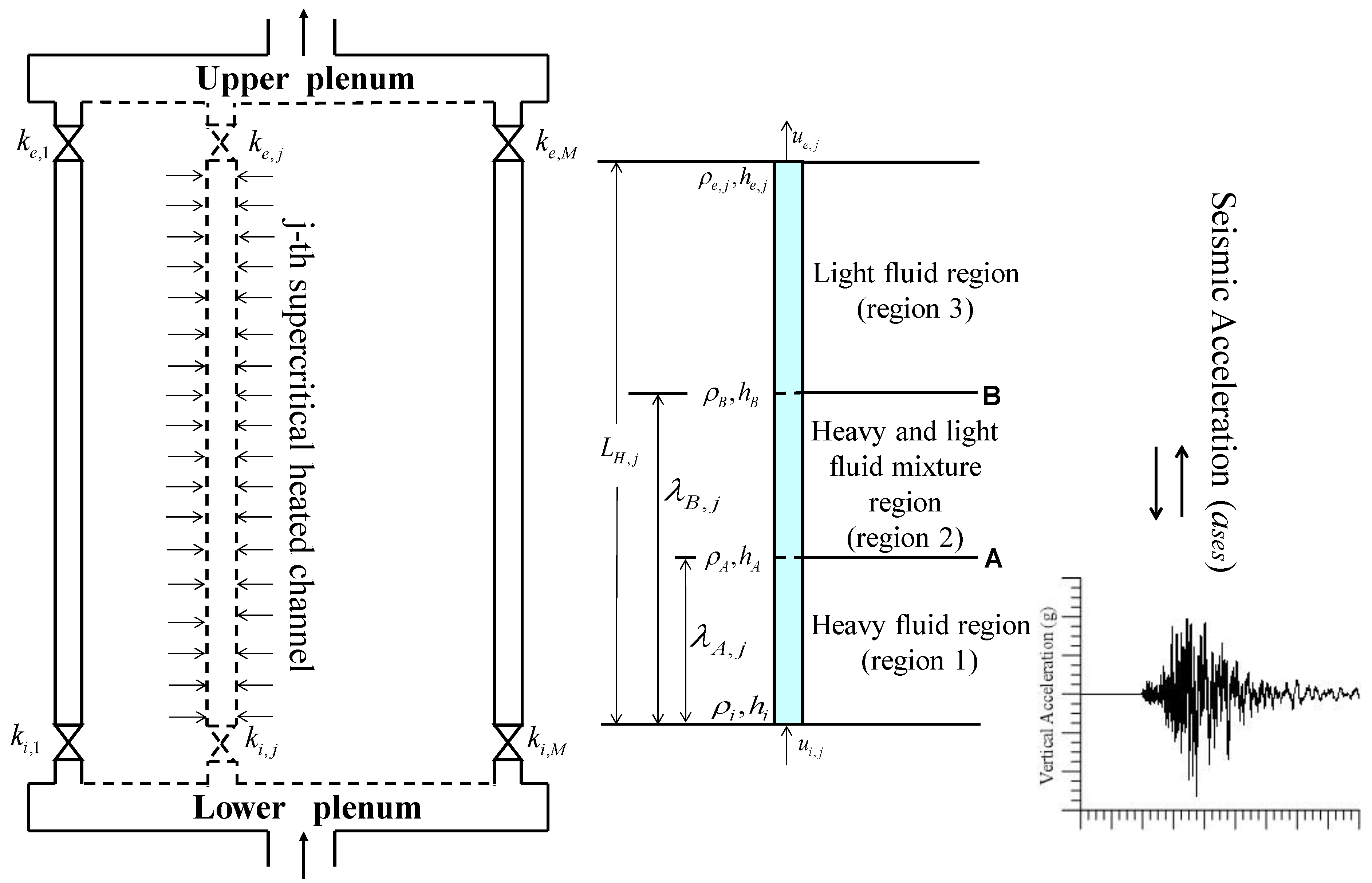
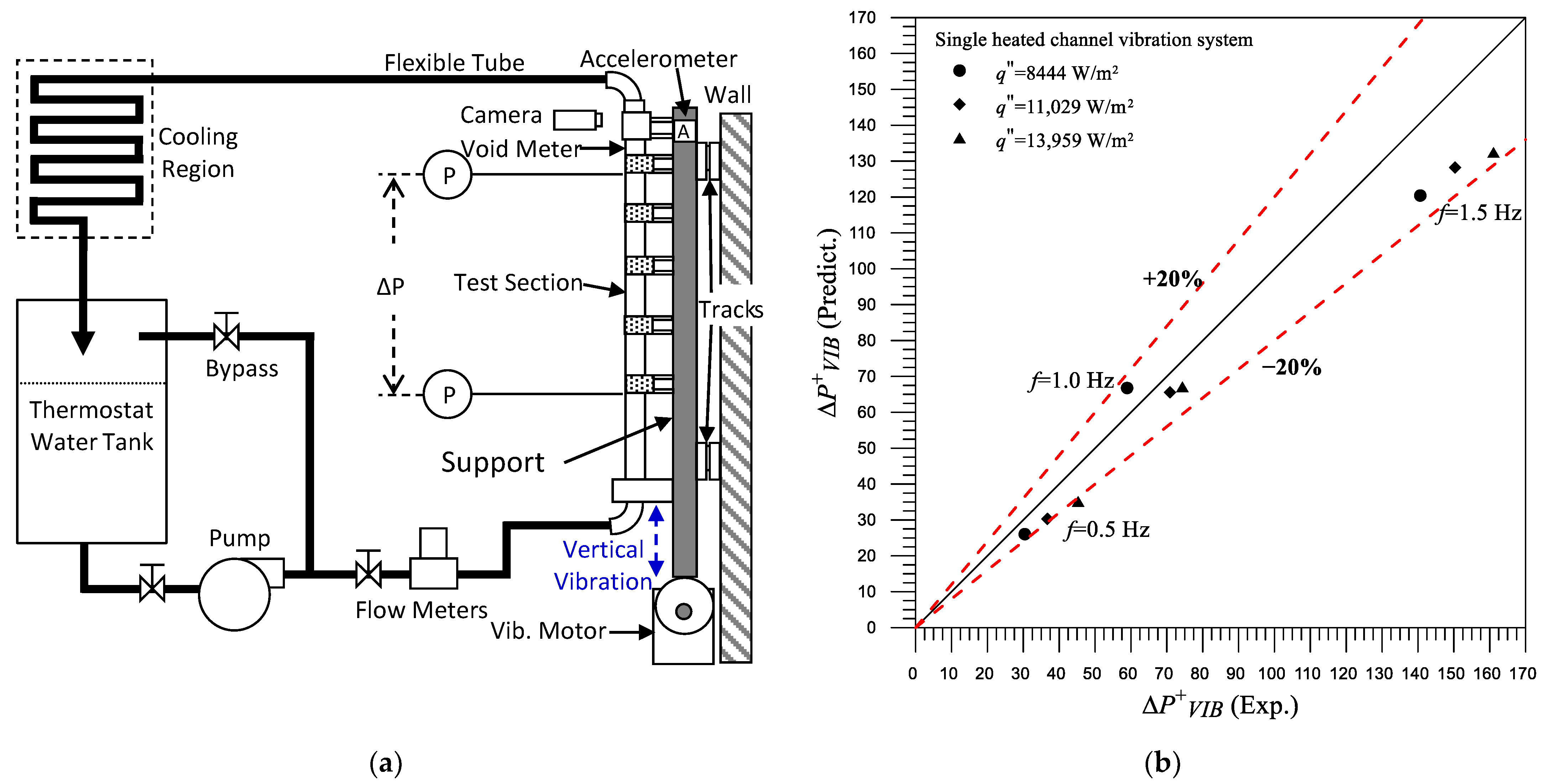
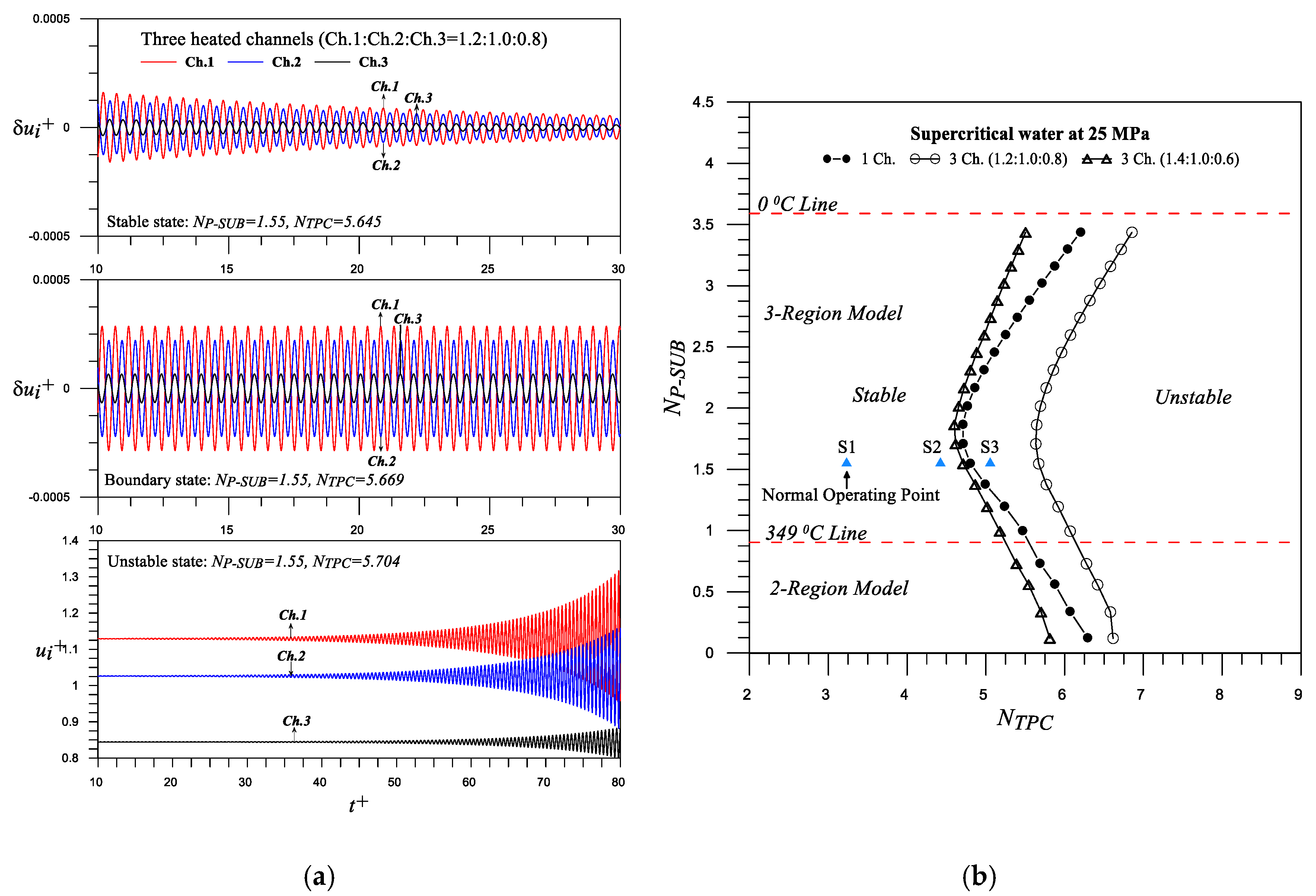
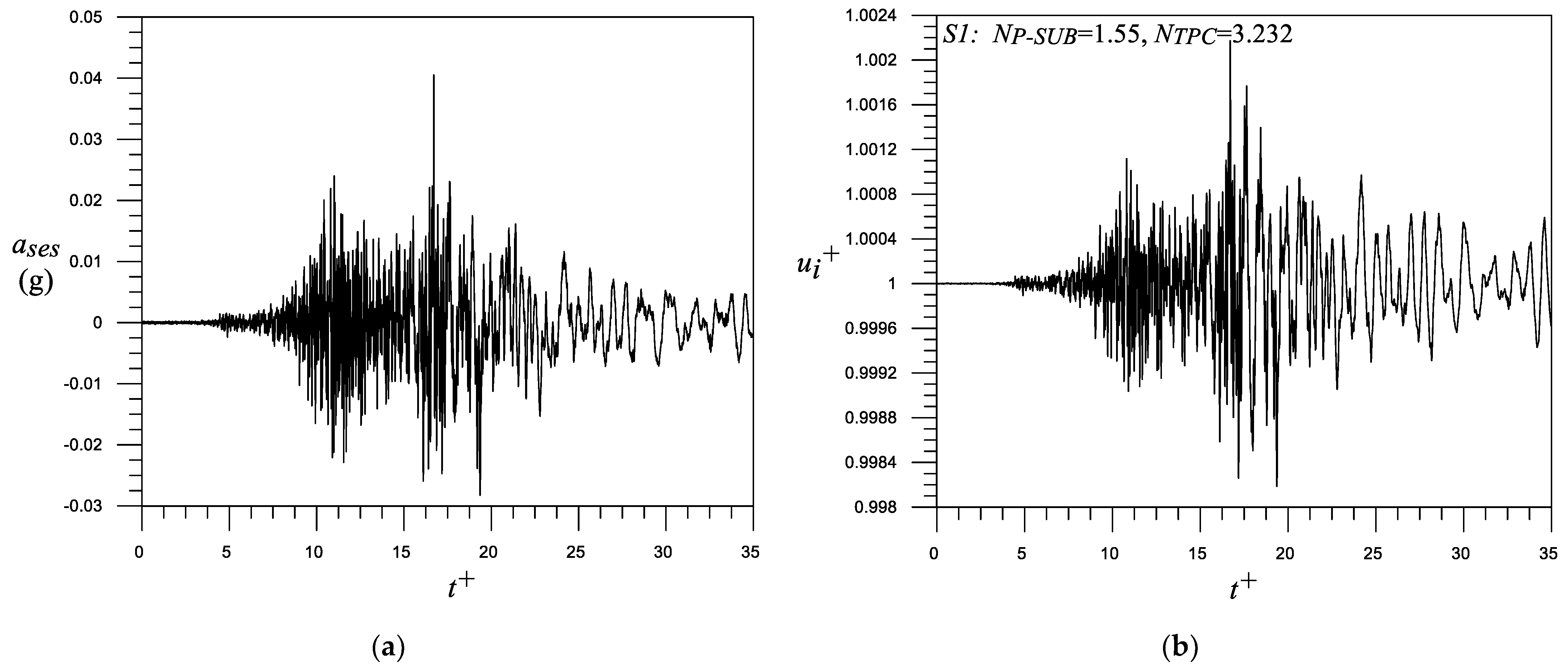
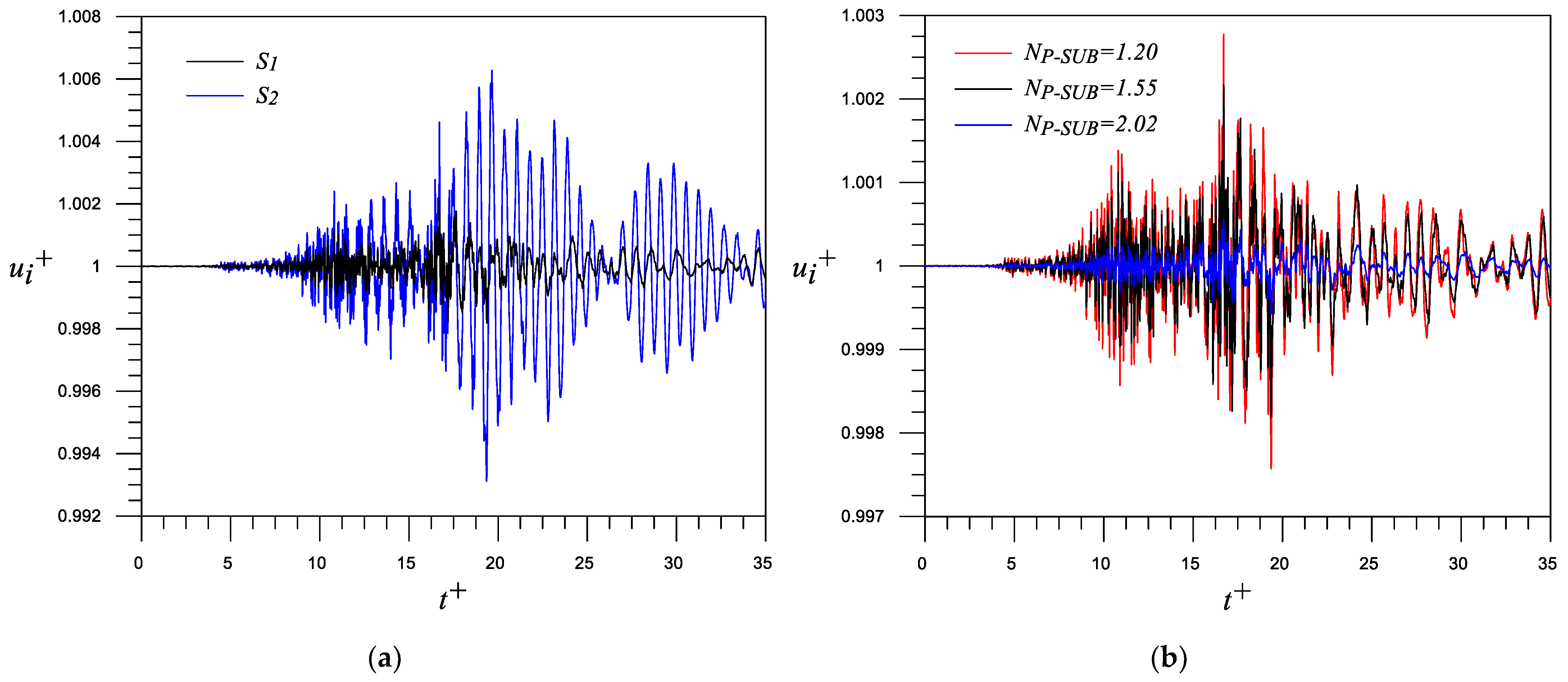

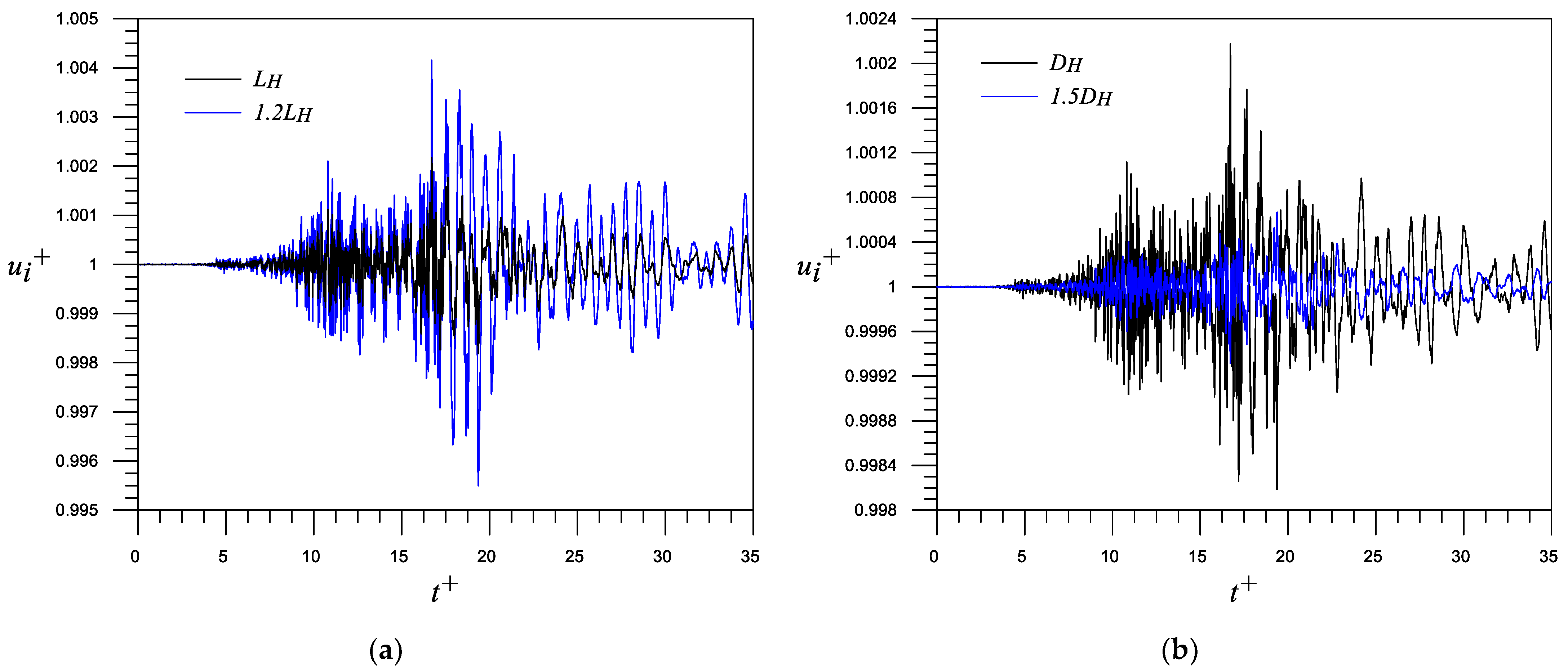
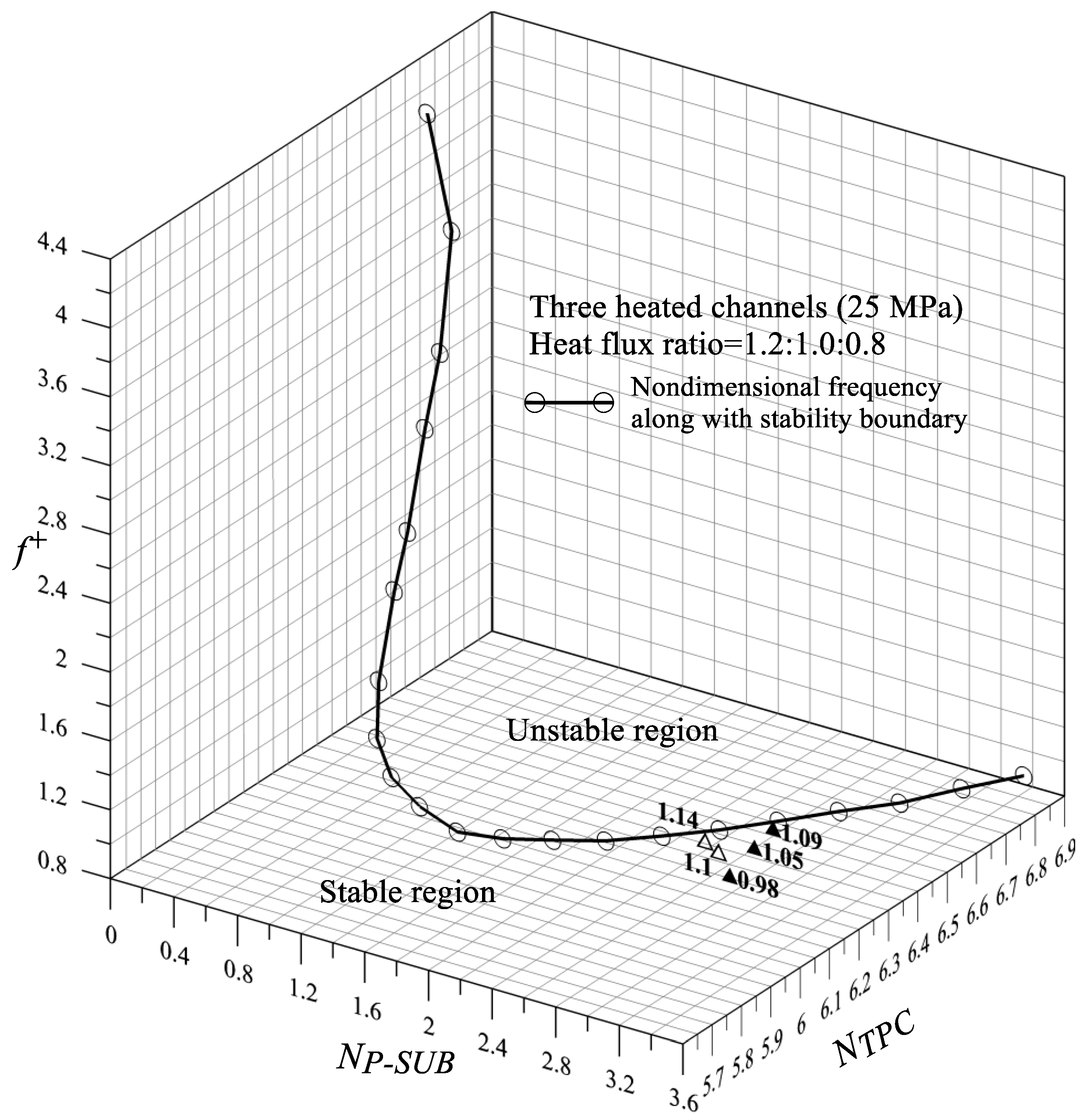
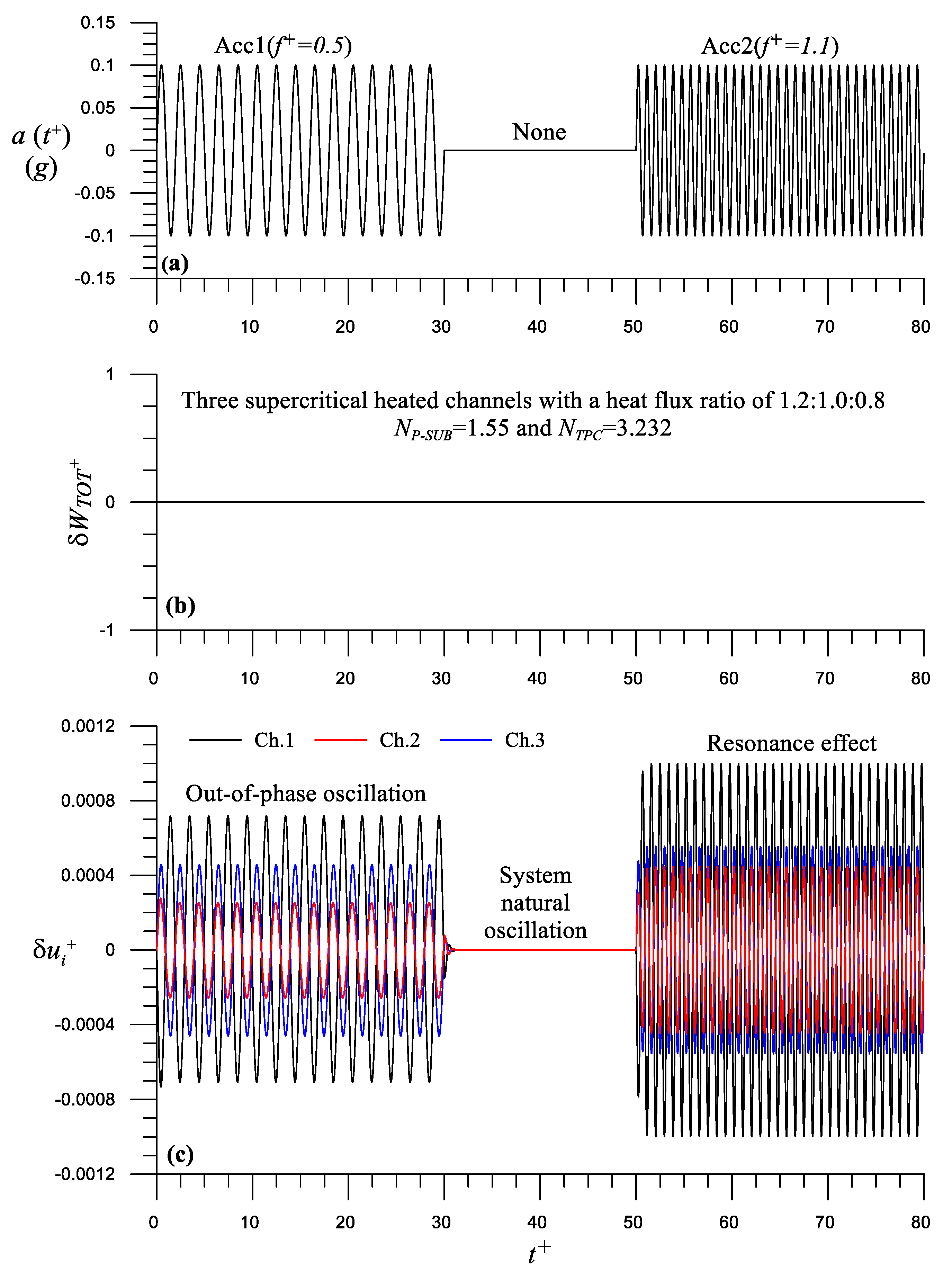

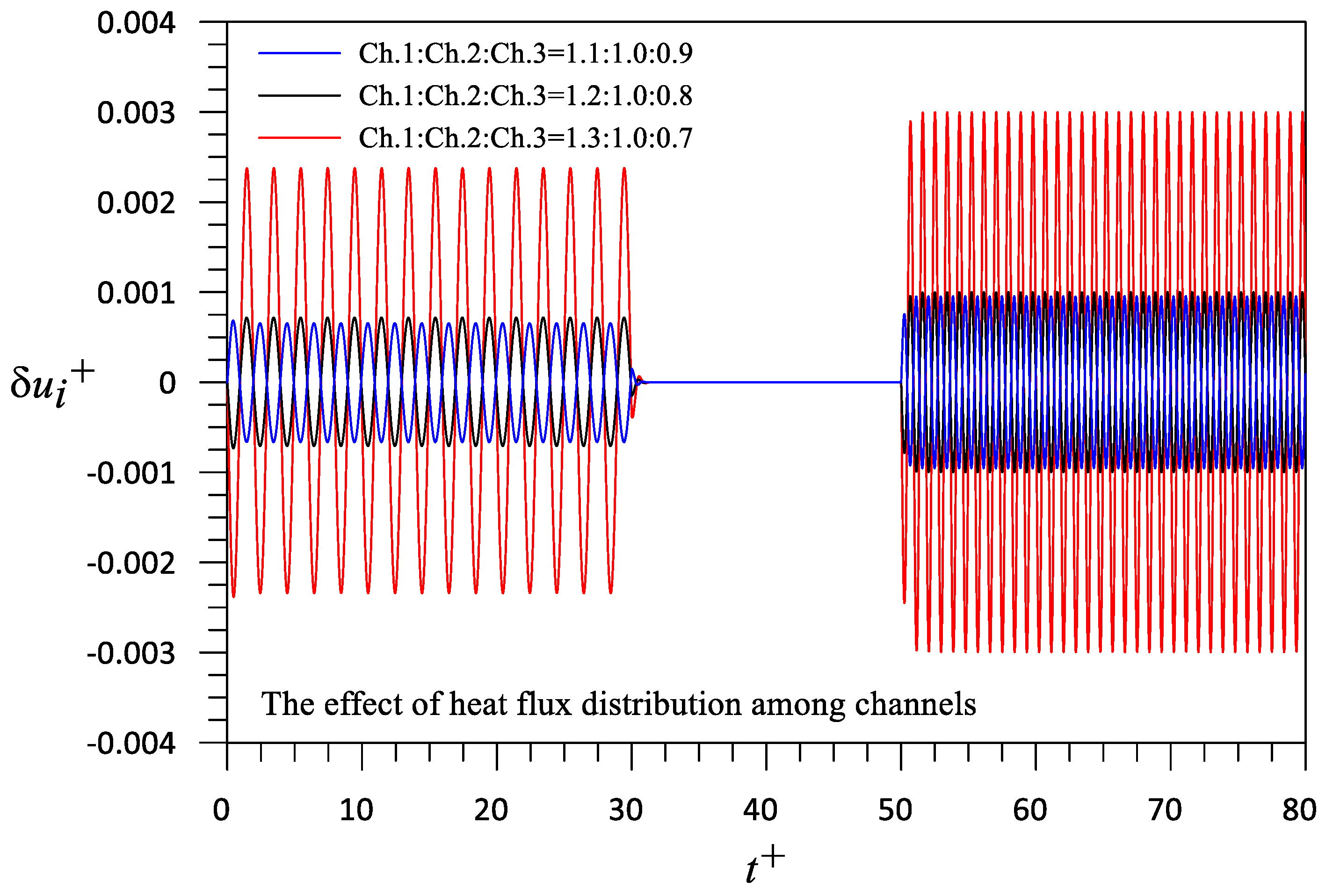
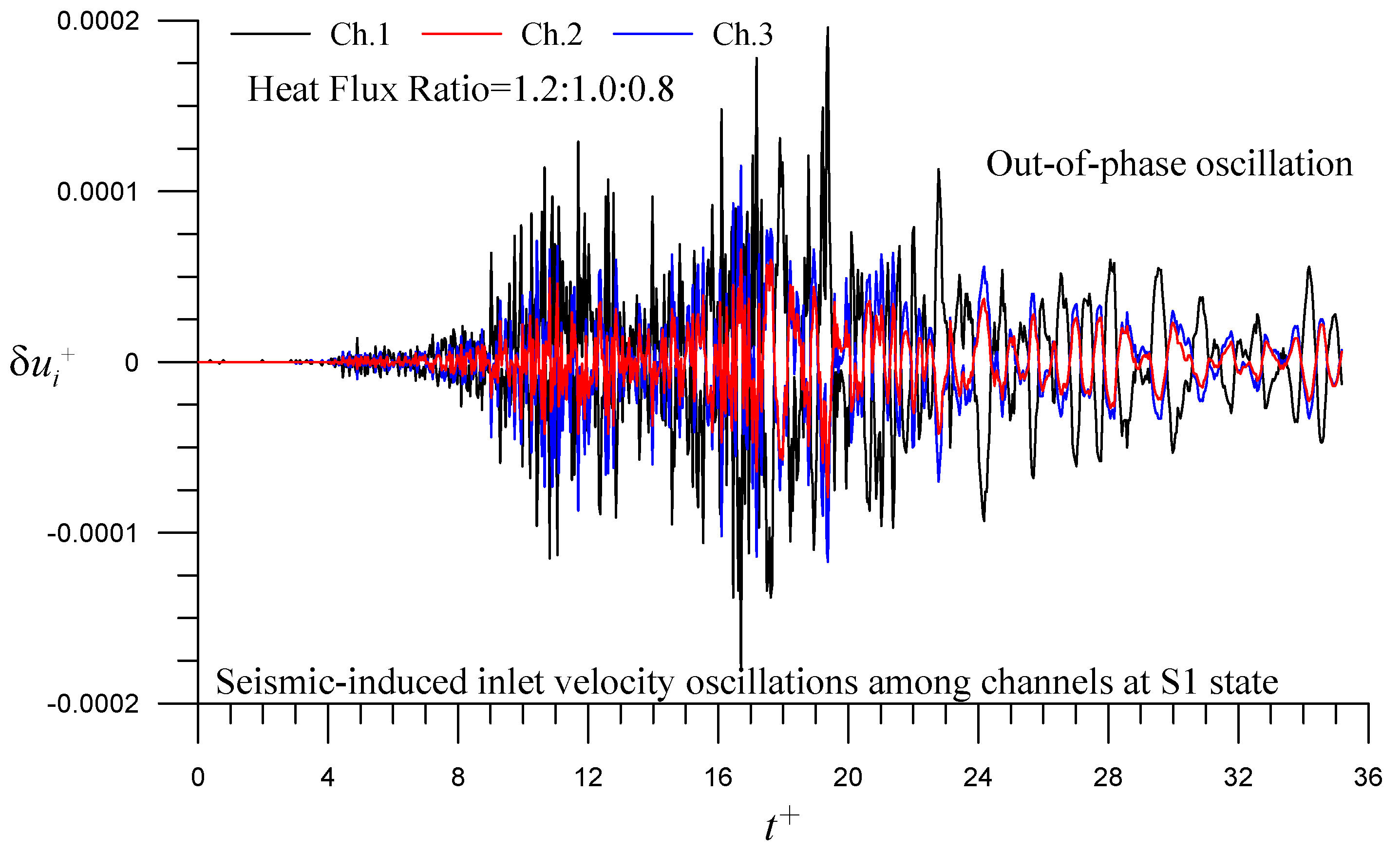

| Parameter | Channel 1 | Channel 2 | Channel 3 |
|---|---|---|---|
| Heat flux ratio | above 1.2 | 0.9 to 1.19 | below 0.9 |
| Length (LH) | 4.2672 m | 4.2672 m | 4.2672 m |
| Diameter (DH) | 3.4 mm | 3.4 mm | 3.4 mm |
| Outlet loss coefficient (ke) | 1.0 | 1.0 | 1.0 |
| Inlet loss coefficient (ki) | 22.7 | 93.0 | 241.1 |
Publisher’s Note: MDPI stays neutral with regard to jurisdictional claims in published maps and institutional affiliations. |
© 2021 by the authors. Licensee MDPI, Basel, Switzerland. This article is an open access article distributed under the terms and conditions of the Creative Commons Attribution (CC BY) license (http://creativecommons.org/licenses/by/4.0/).
Share and Cite
Lee, J.D.; Chen, S.W. Non-Linear Qualitative Dynamic Analysis of Supercritical Water-Heated Channels under External Vertical Accelerations. Appl. Sci. 2021, 11, 1695. https://doi.org/10.3390/app11041695
Lee JD, Chen SW. Non-Linear Qualitative Dynamic Analysis of Supercritical Water-Heated Channels under External Vertical Accelerations. Applied Sciences. 2021; 11(4):1695. https://doi.org/10.3390/app11041695
Chicago/Turabian StyleLee, Jin Der, and Shao Wen Chen. 2021. "Non-Linear Qualitative Dynamic Analysis of Supercritical Water-Heated Channels under External Vertical Accelerations" Applied Sciences 11, no. 4: 1695. https://doi.org/10.3390/app11041695
APA StyleLee, J. D., & Chen, S. W. (2021). Non-Linear Qualitative Dynamic Analysis of Supercritical Water-Heated Channels under External Vertical Accelerations. Applied Sciences, 11(4), 1695. https://doi.org/10.3390/app11041695






